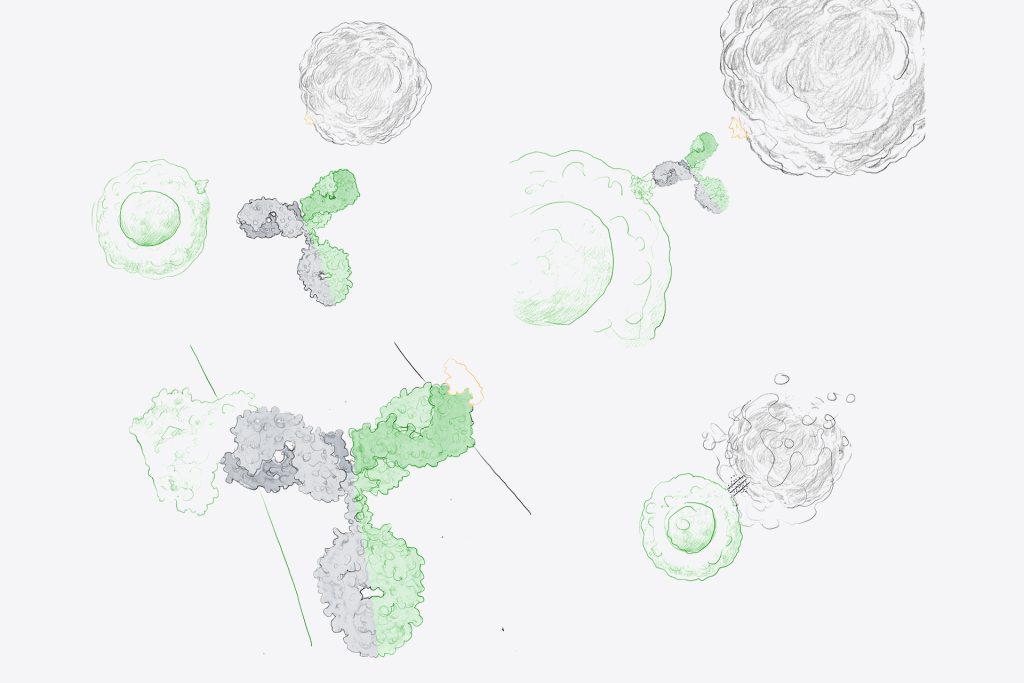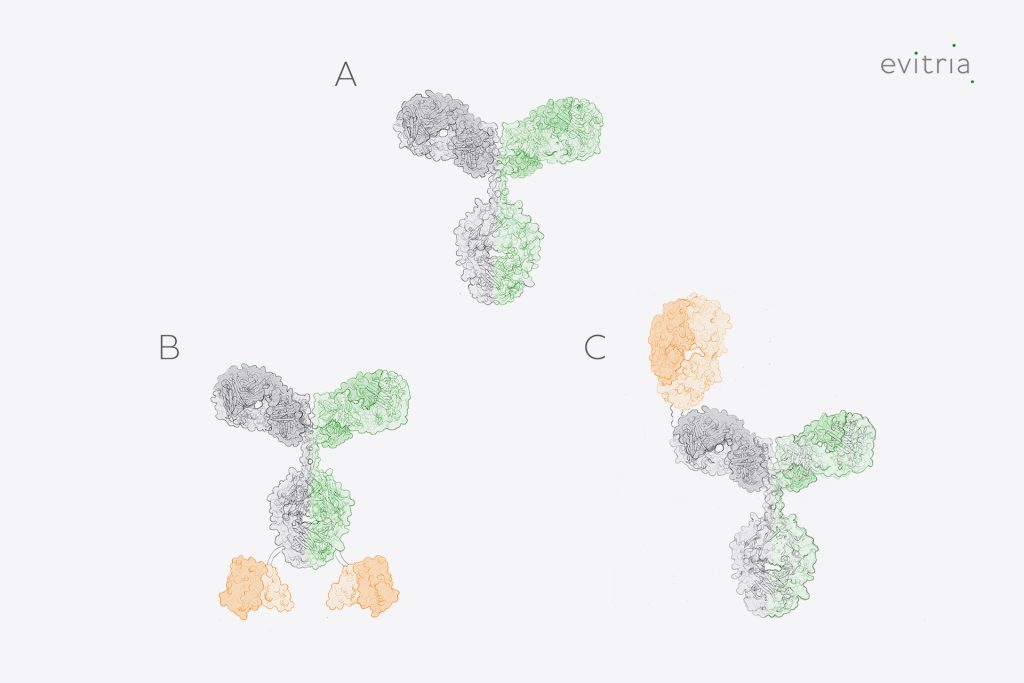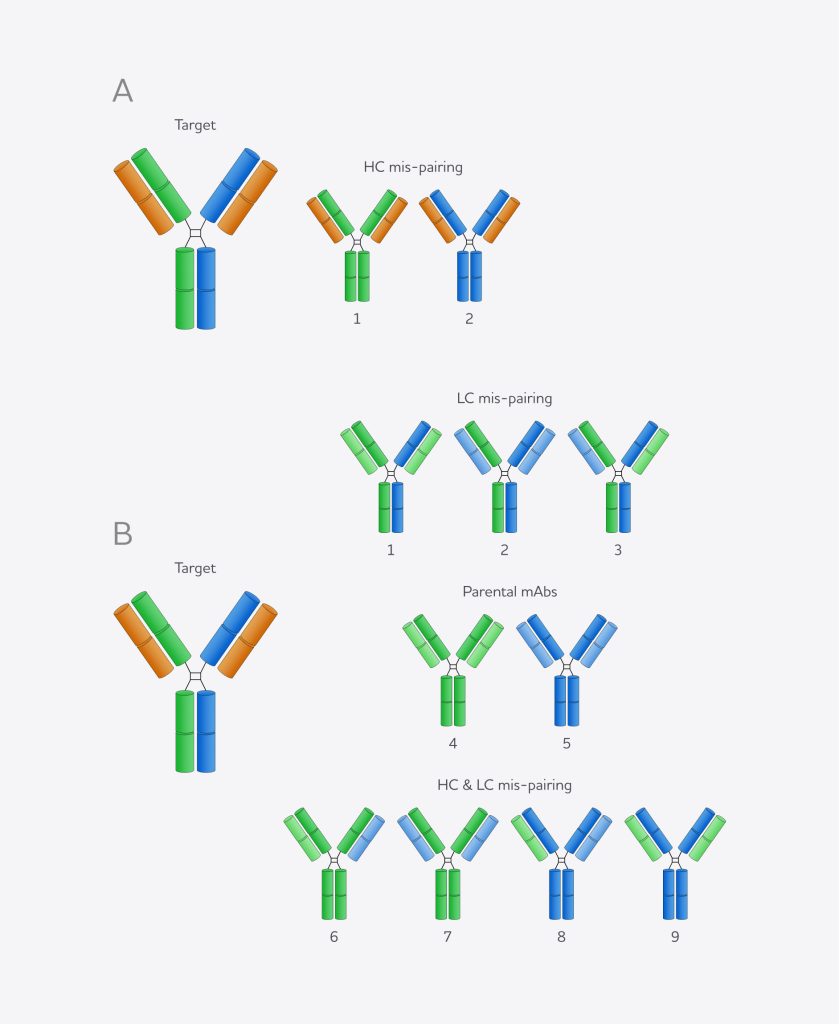Bispecific Antibody Production Service
With our bispecific antibody expression service, we can provide you with high-quality bispecific antibodies in as little as 4 weeks.
In need of a reliable bispecific antibody expression service that ensures proper assembly of constructs? We support the expression of all common bispecific antibody types, including DuoBody® System (Genmab), IgG-scFvs, Knobs-into-Holes, Crossmab, Electrostatic Steering, and other related formats.
Unsure on what format of bispecific antibody you should use in your research? We are happy to guide the design of your constructs – come to us with mAbs, and leave with bsAbs through our bispecific screening program.
120,000 +
transfections performed since our inception in 2010
99%
projects successfully completed on time
20,000 +
antibodies purified for customers worldwide
4 weeks
from antibody sequence to delivery
Bispecific antibody production service – commercial success and research feasibility
Bispecific antibodies are a comparatively new phenomenon in biotech. They have gained huge momentum in the past 10 years, making it difficult for research groups and pharma companies to keep track of all the new associated technologies.
At evitria, we are happy to support our customers not only with our high-quality bispecific antibody production service, but we can also help you to identify the ideal bsAb type for your project with our screening options.
Bispecific antibodies (bsAbs) can be categorized by their activity or by their structural format. By way of activity, trans co-engagers interact with two different epitopes on two different cells, for instance, bringing a T-cell into close proximity with a tumor cell and activating cytotoxic pathways for cell destruction (Figure 1). Cis co-engagers interact with two different antigens on the same cell, thereby improving the selectivity of the antibody and reducing therapeutic side effects.


Bispecific antibody structure and formats
Structurally, antibodies can be categorized based on the number of binding domains they possess (their valency), and how they are divided between the different targets. For instance, bispecific antibodies are often classified as “1 + 1” (two binding sites, one for each target), “2 + 2” (four binding sites, two for each target), or “2+1” (three binding sites, two for one target, one for the other). Further combinations are possible, and more targets can be engaged using multi-specific antibodies.
Additional structural characterization can be made by looking at the format of the bispecific and the sequences used to join the different domains. “Traditional” structures closely resemble regular monoclonal antibodies (mAbs) but have different binding domains on each Fab arm (Figure 2A). These can be further embellished by the addition of other binding regions, such as scFvs or Fab domains, which leads to the creation of multi-specific molecules (Figures 2B and 2C).
Non-antibody bispecifics can be created through the linkage of binding domains without Fc regions. These domains can be antibody fragments, such as individual scFvs (common with bispecific T-cell engagers), Fab domains, VHH domains, or other proteins with an affinity for the desired target(s).
Finally, additional modifications may be added to augment the function of the bispecific molecule. Most frequently, these modifications would be used to silence immune effector functions, which are typically undesirable for trans co-engagers. However, any other mutations used with traditional antibodies can theoretically be transferred into a bispecific antibody.
The choice of which bispecific antibody to use is non-trivial and should be made through a combination of application, manufacturing, and commercial considerations. Our experts are happy to assist you in this decision!
Unsure on what bispecific format you should use?
We’ve got you covered! Regardless of where your research is taking you, Dr. Desmond Schofield is dedicated to supporting you.

Dr. Desmond Schofield
Chief Business Officer at evitria
Bispecific antibodies provided by evitria
Our expertise covers all major bispecific formats as well as proprietary, highly engineered, or unusual constructs. We work closely with you to understand your goals and provide expert guidance on the most suitable bsAb for your research.
For that aim, we support bispecific antibody formats like:
DuoBody® System (Genmab)
This proprietary format is an efficient way to create bispecific antibodies through Fab arm exchange, resulting in a 1+1 antibody format. Two individual IgG1 antibodies with complementary CH3 mutations are expressed separately and combined post-purification. This method ensures high yields without impacting expression and is a straightforward, established procedure.
IgG-scFv
In this 2+2 format, a single-chain variable fragment (scFv) is added to the C-terminus of each heavy chain via a flexible linker. This allows for flexible design of bispecific antibodies. Expression and purification can vary depending on the scFv sequence, and size exclusion chromatography (SEC) polishing is often required for high purity.
Knobs-into-Holes, CrossMab, Electrostatic Steering, and Related Formats
These 1+1 bispecifics are produced by co-expressing two different heavy chains and one or two light chains. They allow for diverse and customized bsAb constructs but may require specialized purification to separate homodimers from heterodimers. Optimization of transfection ratios can improve heterodimer formation.


evitria has access to bYlok® bispecific pairing technology
Thanks to a non-exclusive license agreement with Lonza, we are able to implement bYlok® bispecific pairing technology in our bispecific antibody expression services. This technology addresses a major challenge in bsAb production: HC-LC mispairing.
With bYlok® bispecific pairing technology, we are able to achieve over 95% correct heavy-light chain pairings, significantly improving the effectiveness of our bsAb services. It also allows using CHO cells for the in vitro expression of bsAbs, enabling us to combine the power of this innovative technology with the strengths of our preferred antibody expression cell line.
From sequence to antibody in 4 weeks
We know how tight timelines in biotechnological projects can be. With resources and know-how at hand, our efficient workflow allows us to provide you with bispecific antibodies in as little as 4 weeks. Starting with our molecular biology workflow, large-scale expression commences after 2 weeks, followed by purification, extensive analytics, and – finally – shipment to our customers worldwide.
FAQs on our bispecific antibody production service
Why does evitria use CHO cells for their bispecific antibody production services?
+What are bispecific antibodies?
+What are FDA-approved bispecific antibodies?
+TABELLE NOCH INTEGRIEREN
Table 1 List of bispecific antibodies approved in one or more country worldwide (correct as of April 2024)
What are multispecific antibodies?
+Where are bispecific antibodies successfully applied?
+Read more: Applications of bispecific antibody therapeutics
What are the advantages of bispecific antibodies for therapeutic applications?
+Read more: Advantages of bispecific antibodies and Understanding the side effects of bispecific antibodies.